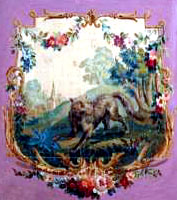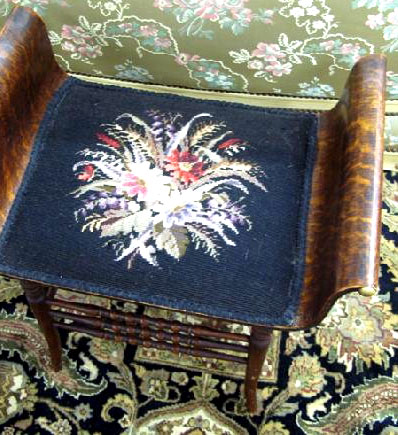TAPESTRIES:
A historical perspective of styles and techniques
To a modern sightseer, the great stone castles of the Middle Ages may seem cheerless and uncomfortable settings for daily life. But they should be imagined as they were in earlier days, the high walls of their principal rooms hung with brightly colored tapestries. Durable, flexible and portable, these hangings were carried from castle to castle with the peripatetic noble households and conveyed an impression of familiar warmth in each setting.
Somewhat paradoxically, modern architecture, with its preference for plain walls, has brought about a.... Read
Full Story
ANTIQUE CLOTHING: Tips for Collectors and Dealers
Space, in the form of attics, trunkrooms and cupboards, allowed people of the past to lay away their clothing. Items were saved because they belonged to a much-loved person, or because the costly fabric could be reused, or because the mores of the time ruled that one did not discard what one owned. Thanks to that squirrel-like mentality, collectors may specialize (bodices, corsets, hats or shoes, for example) according to whim. Certain aesthetes select clothing very much as they would paintings and even appreciate it in much the same way - framed (but under glass). Museums collect according to..... Read
Full Story
CARING and PRESERVING of ANTIQUE CLOTHING
Methods and opinions differ as to the preservation of the fragile coverings of the past, though most experts will agree that in the care of apparel, the less that can be done the better. Purists opt for conservation, which means doing the minimum of cleaning and repair. To them, once a garment that moved on a human body is retired, it never again should be subjected to strain, heat, light or humidity.
When ironing antique dress or similar clothing, try to pad the ironing board and cover it with well-washed, unbleached ..... Read
Full Story
ANTIQUE RUGS: Care and Repair tips for Collectors
One day last year the owner of a Persian rug in Washington, D.C., called the New York dealer she had bought it from and told him that the rug was falling apart. The dealer knew that a fine antique rug such as hers - it was a hundred-year-old Sultanabad - does not suddenly fall apart for no reason. As it turned out, the owner had placed a large plant on the corner of her prize rug. Two years later, when she picked up the plant, she found a hole two feet wide beneath it, and the surrounding area rotting. The metal water tray under ..... Read
Full Story
ANTIQUE SAMPLERS: Collecting Tips
American samplers - that choice bit of Americana all too often brushed off as "schoolgirl embroidery" - are about to bask in the spotlight. Not only does this branch of needlework represent a charming and authentic folk art but, in its way, it also serves as a socio-historical guide for life in America from late in the seventeenth century to the mid-1900s.
Most collections feature a huge variety of themes, quality, schools, teachers and.... Read
Full Story
|
|
|
CHINTZ DESIGNS ON ANTIQUE TEXTILES
CHINTZ, a familiar household word today, first came into our vocabulary in the seventeenth century. It comes from a Hindu word meaning spotted or variegated, and described the charming hand-painted and resist-dyed cottons first imported into Europe from India by the East India Companies. "Spotted or variegated" is a very mild term for some designs, especially when we consider that they were startlingly different from anything seen before in... Read
Full Story
|




